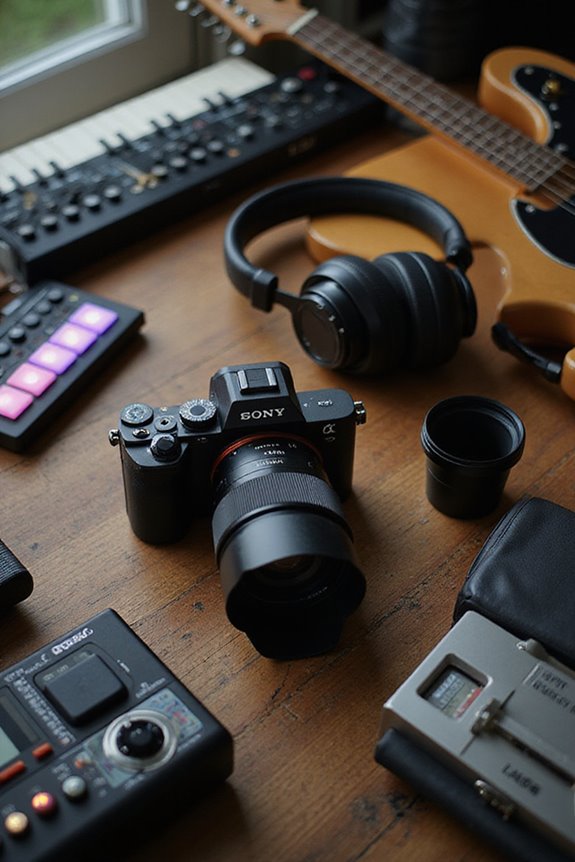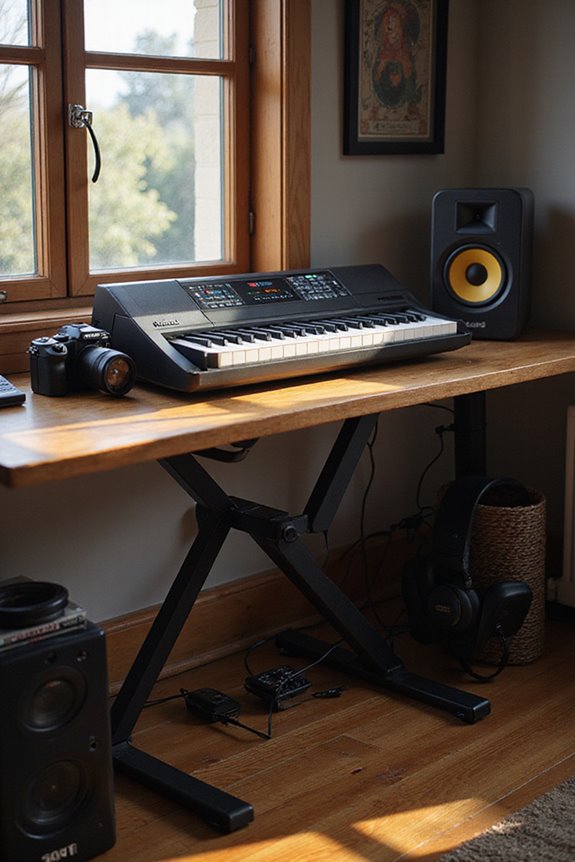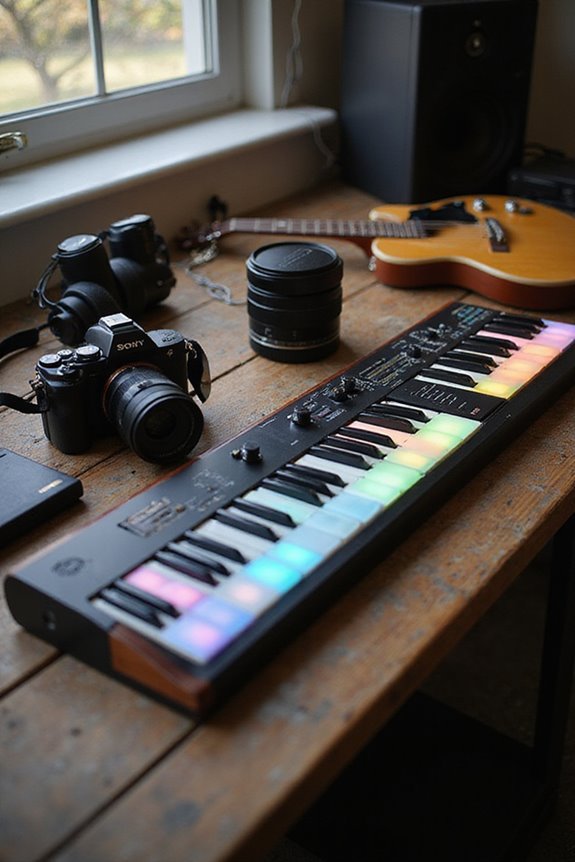Choosing between flatwound and roundwound strings can greatly affect our musical performance. Flatwound strings deliver a warm, smooth tone, perfect for jazz and blues, while roundwounds offer a brighter, more aggressive sound suited for rock or metal. Playability differs too; flatwounds reduce finger noise but may require adjustment for tension. Roundwounds allow easier bends but can increase finger fatigue. Understanding these differences helps us align strings more closely with our genre and playing style; there’s much more to explore!
Key Takeaways
- Flatwound strings provide a dark, warm tone suitable for jazz, while roundwound strings offer a bright, aggressive sound ideal for rock and metal genres.
- Flatwound strings feature a smooth surface that reduces finger noise and fatigue, whereas roundwound strings have a textured surface that enhances grip but can increase finger noise.
- Durability is higher for flatwound strings, leading to less frequent maintenance and longer lifespan, while roundwound strings require more upkeep and are prone to breakage.
- Adjustments in playing technique may be necessary when switching between string types due to differences in tension and feel.
- Personal preference plays a significant role in the choice between flatwound and roundwound strings, influenced by desired tonal qualities and genre applications.
Construction and Material Differences
When we’re diving into the world of guitar strings, understanding construction and material differences is essential for making informed choices. At the heart of every string lies the core wire, typically made from high-carbon steel, providing vital strength and structural integrity. Depending on your preference, this core can be paired with different wrap wire materials and shapes. Flatwound strings feature a flat wrap wire that’s tightly wound to yield a smooth surface, minimizing finger noise. In contrast, roundwound strings use a round wire that produces a textured grip. Each construction affects how we play, so whether we opt for a warmer nickel wrap or a more durable stainless steel, these differences profoundly impact our musical expression.
Tone and Sound Characteristics
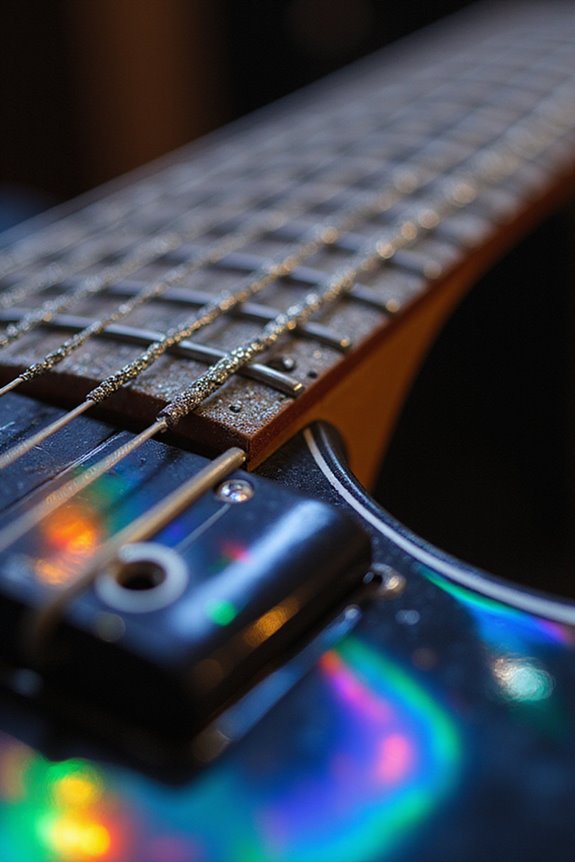
Understanding the nuances of tone and sound characteristics is essential for every guitarist as we choose the right strings. When we consider tone comparison, flatwound strings deliver a darker, warmer tone perfect for jazz and blues, with reduced brightness in sound dynamics. In contrast, roundwound strings provide a brighter, more aggressive tone suited for rock and metal, emphasizing clarity and attack. Their textured surface enriches harmonic overtones, creating a lively sound. Half-round strings offer a middle ground, reducing some brightness but still maintaining dynamics. By selecting strings based on these tonal qualities, we can better match our sound to our genre, ensuring our playing expresses exactly what we aim for in performance.
Playability and Feel
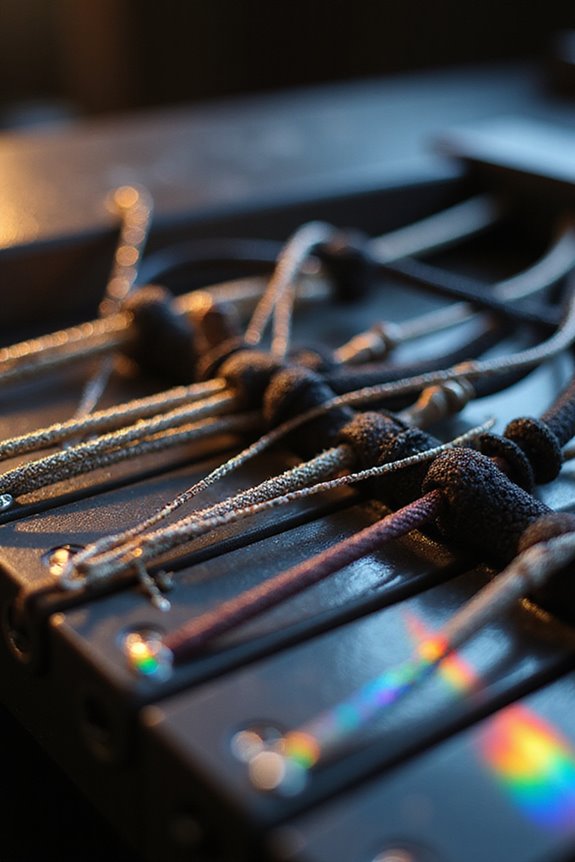
Selecting the right guitar strings is often about more than just tone; it’s also about how they feel when we play. Flatwound strings have higher tension, making tension adjustment a necessity for those who usually prefer roundwounds. This extra tension can lead to greater resistance when bending notes, which may require some adjustment in our playing technique.
On the flip side, the smooth surface of flatwound strings reduces finger fatigue, allowing us to play longer without discomfort. While roundwound strings offer a textured grip and easier bending, they can create more finger noise and irritation over extended sessions. Ultimately, personal preference plays a key role in what feels best for our playing style.
Durability and Maintenance
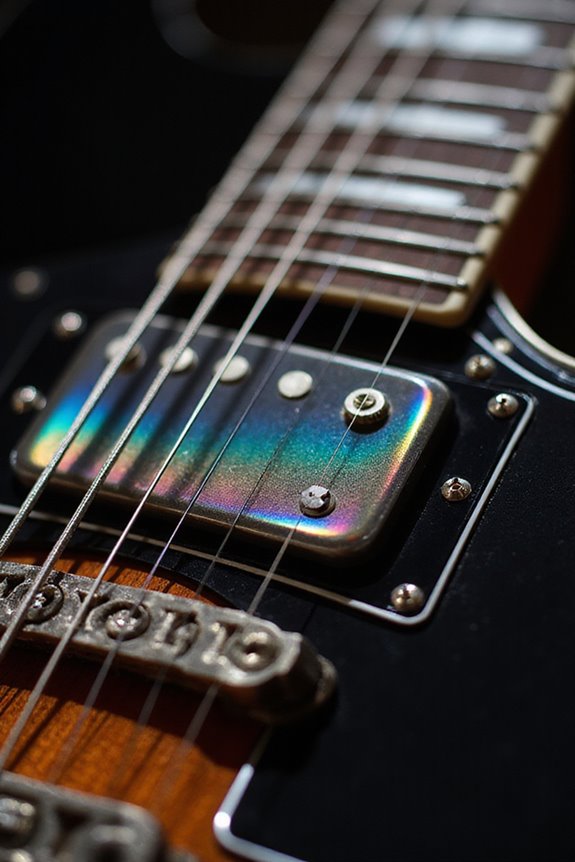
Finding the right balance between playability and durability can greatly enhance our playing experience. Flatwound strings shine regarding string lifespan, largely due to their smooth surface that resists dirt and oil. This means we won’t need to change our strings as often as we might with roundwounds, which trap grime and require more maintenance frequency. Additionally, the reduced fret wear from flatwound strings minimizes the need for extensive instrument upkeep, saving us time and money. While roundwounds can offer flexibility, they’re more prone to breakage and corrosion, making flatwounds a wise choice for those who want longevity. Using them not only boosts our sound quality but also lowers our overall repair costs over time.
Popular Genres and Musical Applications
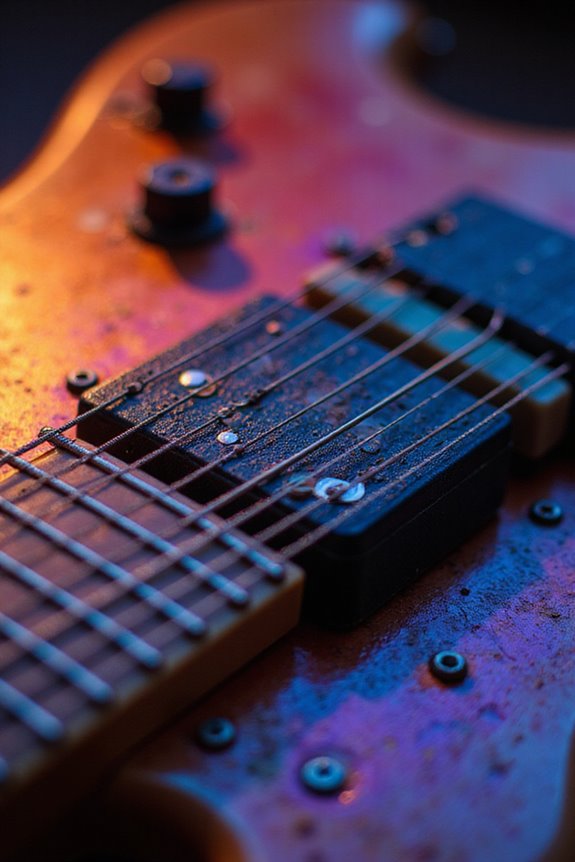
When it comes to choosing guitar strings for different musical styles, it is essential to recognize how each type influences the overall sound and playability. Jazz musicians often prefer flatwound strings for their warm, mellow tones that complement hollow-body guitars. In rock, roundwound strings reign supreme, offering bright, cutting tones ideal for both rhythm and leads.
Blues guitarists frequently use roundwounds for their pronounced highs, while some may opt for flatwounds to achieve a darker sound. In country and surf music, flatwounds provide that classic plunky tone, and roundwounds deliver a vibrant, modern touch. Ultimately, genre influences and string innovations guide our choices, ensuring we achieve the sound perfect for our musical expressions.
Limitations and Considerations
While we often focus on the sound quality and playability of different guitar strings, it’s important to take into account their limitations and practical implications. Flatwound strings, with their smoother surface, may require more time to adapt our playing techniques due to their stiffness and darker tone. They’re pricier and less accessible, making them a consideration for budget-conscious players. On the other hand, roundwound strings often create unwanted string noise and can wear out frets faster, detracting from our instrument’s longevity. While they provide brighter tones and increased sustain, the rough feel may not suit everyone. Ultimately, balancing these limitations with our individual playing style can guide us in making the right choice.
String Selection Based on Playing Style
Understanding how different strings impact our playing style is essential for achieving the sound we desire. Players with varied experiences might prefer specific string thicknesses that suit their genre. For instance, flatwound strings provide a mellow tone, ideal for jazz and blues players who appreciate smoothness and reduced finger noise. Conversely, roundwound strings offer brightness and clarity, making them a favorite among rock guitarists or those who utilize techniques like bends and slides.
The stiffness of flatwound strings can feel challenging for bending, while roundwounds facilitate faster lead playing. Ultimately, choosing the right strings enhances our performance, aligning our tonal preferences with our musical expression. It’s about finding what fits our unique style best.
Recommended Brands and Products
Choosing the right guitar strings can feel overwhelming with so many options available. When we look at brand comparisons, D’Addario is a solid choice for both flatwound and roundwound strings. Their ECG24 flatwounds are loved by jazz guitarists for excellent playability and sustain. If you’re after roundwounds, their Nickel set offers longevity without breaking the bank.
Thomastik Infeld strings provide a premium experience for serious players, delivering a warm, classic jazz tone. For those desiring a vintage sound, Ernie Ball’s flatwounds are known for exceptional quality and smooth playability. Finally, if you play a gypsy guitar, consider Argentines for their value and quality. By evaluating these product recommendations, you’ll find the perfect strings to suit your style and preferences.
Transition Tips Between Flatwound and Roundwound
Switching between flatwound and roundwound strings can greatly impact our playing experience. To guarantee a smooth shift, we must prioritize technique adjustment and tension adaptation. Flatwounds require increased finger strength, so practicing fretting pressure is essential to avoid buzzing. Expect tonal recalibration; the darker tones of flatwounds might alter our amp settings and playing dynamics.
An action setup may also be necessary due to the different string tensions. Don’t forget to adjust our picking technique; flatwounds provide a smoother attack and less pick noise, enhancing our sliding control. Vibrato practice becomes vital as the flatwound stiffness changes how we approach bends. Ultimately, embracing these adjustments can lead to fatigue reduction and increased dynamic sensitivity in our playing.
Personal Preferences and Experimentation
When exploring guitar strings, personal preferences and experimentation play an essential role in finding what truly resonates with us as players. We often find ourselves experimenting with different types, weighing our personal experiences against the demands of our musical styles. For instance, jazz players might gravitate toward flatwounds for their warm, mellow tones, while rock musicians might prefer roundwounds for their bright attack and sustain. It’s all about context; lighter string gauges work well for intricate solos, and heavier ones provide a firmer feel for aggressive strumming. By diving into string experimentation, we can discover which combination of tone, playability, and feel complements our unique approach to guitar playing, leading to a more authentic sound.
Frequently Asked Questions
How Do I Know Which Gauge to Choose?
When deciding which gauge to choose, we should consider string thickness and our tonal preferences. Lighter strings can enhance agility, while heavier ones provide warmth and sustain, allowing us to tailor our sound more effectively.
Can I Mix Flatwound and Roundwound Strings?
Imagine a tapestry woven with different threads, each offering its own tone preference. We’ve discovered that mixing flatwound and roundwound strings could blend string longevity and warmth, creating a beautiful sonic landscape worth exploring together.
How Often Should I Change My Strings?
We believe our string lifespan depends on how often we play. Generally, changing frequency should be every 1-2 weeks for regular playing, but casual players might stretch it to every 2-3 months for maintenance.
What Tools Do I Need for String Replacement?
When we’re string changing, we need essential tools like a guitar winder, cutters, and a neck cradle. These items make the process smoother and safer, ensuring our instruments stay in top condition during the swap.
Do Different Guitars Affect String Choice?
Oh, we thought every guitar was created equal! But really, guitar type dramatically influences our string choice, shaping tone preference and playing style. It’s like picking clothes based on the weather—essential but often overlooked.

